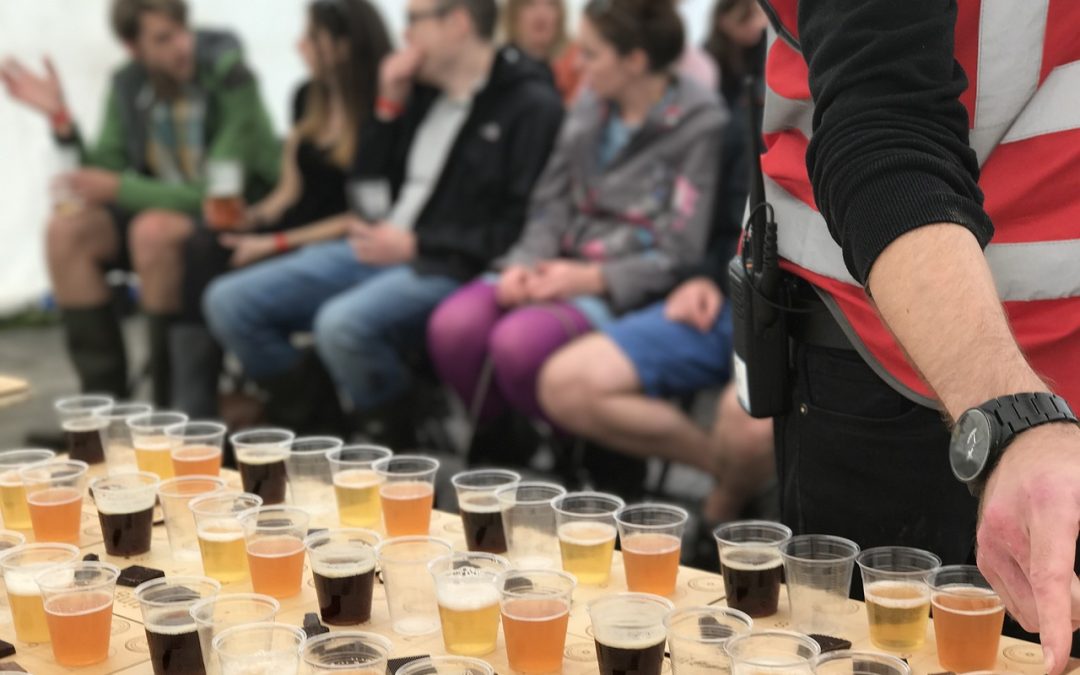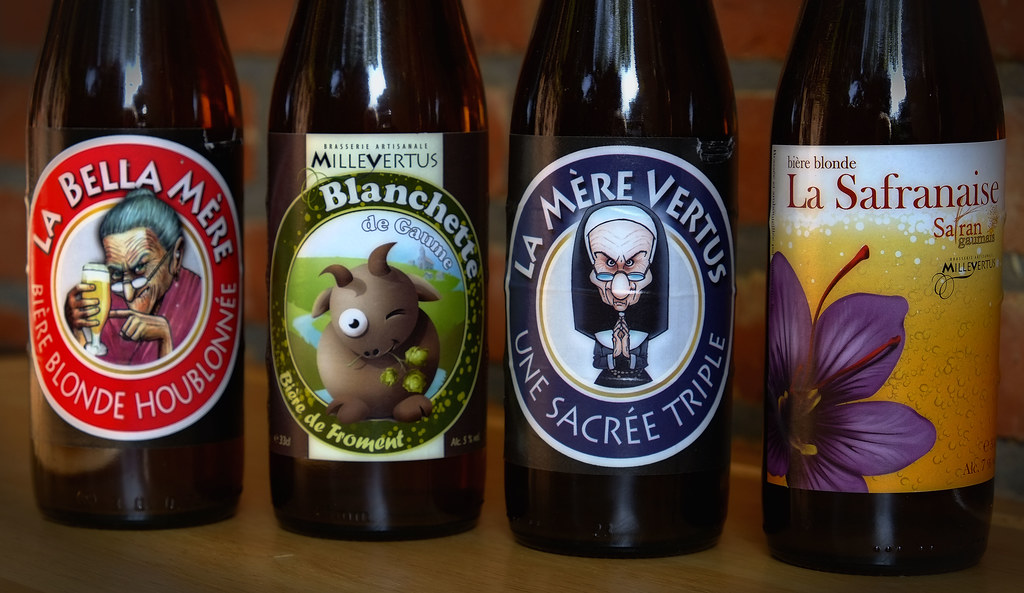Craft beer has taken the world by storm, and it’s not hard to see why. The variety of flavors and the passion behind every brew have sparked a revolution in the beer industry. In this article, we will explore the fascinating world of craft beer, where innovation and creativity know no bounds. From unique flavor combinations to experimental brewing techniques, get ready to take a closer look at the exciting and ever-evolving world of innovative specialty beers. So grab a cold one and join us on this tantalizing journey!
The History of Craft Beer
Craft beer has a rich and vibrant history that dates back centuries. Originating in the homes and small breweries of passionate beer enthusiasts, craft beer was a labor of love, showcasing the artistry and skill of its creators. Over time, it has evolved into a global phenomenon, with countless breweries across the world dedicated to producing unique and exceptional flavors.
Origin of Craft Beer
The origins of craft beer can be traced back to ancient civilizations. Throughout history, people have been brewing their own beer using simple ingredients such as barley, yeast, and water. However, it was during the Middle Ages that the art of crafting beer truly took off. Monks in European monasteries perfected the brewing process, creating distinct beer styles that were enjoyed by locals and pilgrims alike. These early pioneers laid the foundation for the craft beer movement we know today.
Early Craft Beer Pioneers
In the United States, the craft beer movement gained momentum in the late 20th century. A handful of passionate individuals set out to challenge the dominance of mass-produced beers by introducing innovative flavors and brewing techniques. Brewers like Fritz Maytag, founder of the Anchor Brewing Company, and Ken Grossman, founder of Sierra Nevada Brewing Company, paved the way for the craft beer revolution. Their dedication to quality and their willingness to push boundaries inspired others to follow in their footsteps.
Growth and Popularity of Craft Beer
The craft beer industry has experienced tremendous growth and popularity in recent years. With the increasing demand for unique and flavorful beers, craft breweries have flourished, offering beer lovers an endless variety of options. This growth has been driven by consumers’ desire for high-quality, locally-made products that defy the conventional norms. Craft beer has become more than just a beverage; it has become a means of expression and a symbol of community and creativity.
Defining Specialty Beers
Craft beer is often synonymous with specialty beers. These are beers that go beyond the traditional styles and delve into new and exciting flavor profiles. They are crafted using different ingredients, fermentation techniques, and aging processes, resulting in beers that are truly unique.
Differentiating Specialty Beers from Regular Beers
What sets specialty beers apart from regular beers is their focus on experimentation and innovation. While regular beers adhere to established brewing traditions and styles, specialty beers push boundaries and break the mold. They are not constrained by convention or expectations, allowing for the exploration of new flavor combinations and brewing techniques.
Characteristics of Specialty Beers
Specialty beers can be characterized by their complexity, bold flavors, and often high alcohol content. Brewers often incorporate unconventional ingredients such as fruits, spices, or even coffee to create beers that captivate the palate. These beers are often brewed in small batches, allowing for more attention to detail and a higher level of craftsmanship. From the hop-forward bitterness of an IPA to the rich and roasty notes of a stout, specialty beers offer an abundance of flavors and experiences.
Popular Styles of Specialty Beers
With the vast array of specialty beers available, it can be overwhelming to navigate the world of craft beer. Here are some popular styles that have garnered a loyal following:
India Pale Ales (IPAs)
IPAs are known for their strong hop flavors and aromas. They originated in England and were brewed for export to British colonies in India. Breweries began adding extra hops to the beer to preserve it during the long journey, resulting in a beer style that is characterized by its bitterness and citrusy, floral hop characteristics. IPAs have become one of the most popular craft beer styles, with variations ranging from the classic English IPA to the bold and hop-forward American IPAs.
Sours and Wild Ales
Sour beers and wild ales are defined by their tart and acidic flavors. These beers are typically brewed using wild yeast or bacteria, which give them their distinct sourness. With their refreshing and complex flavors, sours have gained a dedicated following among craft beer enthusiasts. Styles such as Gose, Berliner Weisse, and Lambic showcase the diversity of sour beers, each offering a unique taste experience.
Stouts and Porters
Stouts and porters are dark, rich, and full-bodied beers that are often associated with colder climates. They are characterized by their roasted malt flavors, which give them notes of coffee, chocolate, and caramel. Stouts and porters come in various sub-styles, including oatmeal stouts, milk stouts, and imperial stouts, each with its own twist on the traditional flavor profile. These beers are often enjoyed as a dessert or a warming treat on a chilly evening.
Belgian-Style Ales
Belgian-style ales encompass a wide range of beer styles, each with its unique characteristics. Belgian beers are known for their complex flavors, fruity esters, and spicy phenols. From the renowned Trappist beers brewed by monks to the distinctive farmhouse ales, Belgian-style beers offer a diverse and intriguing taste experience. They often have a higher alcohol content and exhibit flavors of banana, clove, and bubblegum.
Wheat Beers
Wheat beers, as the name suggests, are brewed primarily with wheat malt. These beers are known for their refreshing and light-bodied nature, making them perfect for warm summer days. Styles such as Hefeweizen and Witbier are characterized by their fruity and spicy flavors, often accompanied by a hazy appearance and a fluffy white head. Wheat beers are a popular choice among beer lovers looking for a crisp and easy-drinking option.
Unique Ingredients and Brewing Techniques
Craft brewers are known for their creativity and willingness to experiment with unconventional ingredients and brewing techniques. This constant innovation has led to the development of countless unique and boundary-pushing beers.
Unconventional Ingredients in Specialty Beers
Craft brewers have embraced the use of a wide range of ingredients to add depth and complexity to their beers. From fruits, spices, and herbs to coffee, chocolate, and even bacon, brewers have pushed the boundaries of flavor by incorporating unexpected elements. These ingredients not only enhance the taste of the beer but also provide an opportunity for brewers to showcase their creativity and culinary skills.
Barrel-Aging and Secondary Fermentation
Barrel-aged beers are a testament to the patience and craftsmanship of brewers. These beers are aged for an extended period in wooden barrels, often previously used for aging spirits such as whiskey or wine. The barrels impart unique flavors and aromas to the beer, creating a complex and rich profile. Secondary fermentation, on the other hand, involves adding additional yeast or bacteria to the beer after the initial fermentation. This process can result in unique flavors and can also contribute to the beer’s carbonation.
Dry-Hopping and Hop Bursting
Hops are a crucial ingredient in beer, providing bitterness, flavor, and aroma. Dry-hopping is a technique where hops are added to the beer during or after fermentation, allowing the flavors and aromas to infuse without adding additional bitterness. This process enhances the hop character of the beer, resulting in a more pronounced and vibrant hop profile. Hop bursting, on the other hand, involves adding a large amount of hops during the brewing process, providing intense hop flavors and aromas without excessive bitterness.
The Rise of Collaborations
In recent years, collaborations have become a prominent trend within the craft beer industry. Breweries have joined forces with each other and with other industries to create unique and exciting beers that push boundaries and challenge expectations.
Brewery Collaborations
Collaborations between breweries allow for the sharing of knowledge, expertise, and resources. Brewers come together to create one-of-a-kind beers that combine their unique styles and techniques. These collaborations often result in limited-edition releases that generate excitement among craft beer enthusiasts. They provide an opportunity for breweries to learn from each other and to showcase their creativity and passion for brewing.
Cross-Industry Collaborations
Craft breweries have also embraced collaborations with other industries, such as coffee roasters, chocolatiers, and even musicians. These collaborations result in beers that incorporate the flavors and characteristics of the partner industry’s products. With coffee-infused stouts, chocolate-flavored porters, and beer-inspired by a favorite band, cross-industry collaborations bring together the best of both worlds, creating truly memorable and innovative beers.
Experimental Brewing Methods
Craft brewers are constantly pushing the boundaries of what is possible in beer production. They are not bound by tradition or convention, allowing for experimentation with alternative ingredients, fermentation techniques, and brewing processes.
Brewing with Alternative Grains
Craft brewers have begun using alternative grains such as rye, spelt, quinoa, and even ancient grains like millet and sorghum. These grains provide unique flavors and textures, adding a new dimension to the beer. By incorporating alternative grains, brewers can create beers that are gluten-free or cater to individuals with specific dietary requirements.
Exploring New Fermentation Techniques
In addition to traditional brewing methods, craft brewers are exploring new fermentation techniques to create distinctive flavors and aromas. For example, open fermentation, where the beer is brewed in vessels that allow wild yeast and bacteria to enter, can produce complex and funky flavors. Other techniques, such as spontaneous fermentation, involve exposing the beer to the natural yeast present in the environment, resulting in unique and unpredictable flavors.
Utilizing Local and Seasonal Ingredients
Craft brewers are increasingly sourcing ingredients locally, reflecting the terroir of the region and supporting local farmers and producers. By using locally-grown hops, fruits, herbs, and other botanicals, brewers can showcase the flavors and characteristics of their surroundings. Seasonal ingredients also play a crucial role, with beers showcasing the bounty of each season, whether it’s fresh berries in the summer or spices and pumpkin in the fall.
Gaining Inspiration from Other Beverages
Craft brewers draw inspiration not only from the world of beer but also from other beverages. They experiment with techniques and ingredients commonly used in winemaking, distilling, and even cocktail production. This cross-pollination of ideas and flavors results in beers that offer a unique twist and provide a bridge between different beverage worlds.
Innovations in Packaging and Serving
Craft brewers are not only focused on what’s inside the bottle or can but also on how it is packaged and served. Innovations in packaging and serving have revolutionized the craft beer experience, making it more convenient and enjoyable for consumers.
Canning Revolution
The shift from traditional glass bottles to cans has been a game-changer in the craft beer industry. Cans offer several advantages over bottles, including better protection against light and oxygen, increased portability, and reduced environmental impact. Canned beers are lightweight, easy to stack, and can be enjoyed in a variety of settings, from the beach to the backcountry.
Crowlers and Growlers
These are containers that allow consumers to purchase draft beer directly from the brewery and enjoy it at home. Crowlers are large cans that are filled and sealed on-demand, providing a convenient and portable option for enjoying fresh beer. Growlers, on the other hand, are reusable glass or stainless steel containers that can be filled and refilled at the brewery or taproom. They offer a more sustainable option for enjoying draft beer and allow consumers to sample a wide variety of beers.
Nitro Beers and Innovative Tap Systems
Nitrogen-infused beers, commonly referred to as nitro beers, have gained popularity in recent years. Nitrogen provides a smooth and creamy texture, enhancing the drinking experience. These beers are often poured using specialized tap systems that infuse the beer with nitrogen as it is poured. This results in a cascading effect that creates a visually appealing presentation and contributes to the unique mouthfeel of the beer.
The Role of Technology and Social Media
Technology and social media have played a significant role in the growth and success of the craft beer industry. They have provided breweries with new avenues to connect with consumers, promote their products, and enhance the overall beer-drinking experience.
Digital Marketing and Online Presence
Craft breweries have embraced digital marketing and online platforms to reach a wider audience. Social media platforms like Instagram, Facebook, and Twitter have become essential tools for breweries to connect with beer enthusiasts and share updates about new releases, events, and behind-the-scenes content. Websites and online stores allow consumers to easily access information about breweries and their offerings, making it convenient to discover and purchase craft beers.
Untappd and Beer Rating Apps
Untappd and other beer rating apps have revolutionized how beer drinkers discover and rate craft beers. These apps allow users to track and share the beers they have tried, rate and review them, and discover new options based on their preferences. Breweries can use these apps to gain insights into consumer preferences and trends, as well as to engage with their audience directly.
Virtual Beer Festivals and Online Events
The COVID-19 pandemic prompted the rise of virtual beer festivals and online events. Craft breweries quickly adapted to the changing landscape by organizing virtual tastings, beer releases, and even beer festivals that could be enjoyed from the comfort of one’s home. These online events have allowed breweries to maintain a sense of community and connection with their customers, even when physical gatherings were not possible.
Sustainability and Ethical Brewing
Craft brewers understand the importance of sustainability and ethical brewing practices. They strive to minimize their environmental impact and contribute positively to their local communities.
Eco-Friendly Brewing Practices
Craft breweries have made significant strides in adopting eco-friendly brewing practices. They invest in energy-efficient equipment, utilize renewable energy sources, and implement water-saving measures. Additionally, many breweries focus on waste reduction and recycling, finding creative ways to repurpose spent grain and other byproducts of the brewing process.
Supporting Local Communities
Craft breweries are often deeply rooted in their local communities. They actively support local charities, participate in community events, and collaborate with neighboring businesses. Breweries have become gathering spaces, bringing people together and fostering a sense of community. By supporting local breweries, consumers can directly contribute to the growth and development of their own communities.
Giving Back to the Environment
Many craft breweries recognize the importance of giving back to the environment and support initiatives aimed at conservation and restoration. Some breweries have partnered with organizations focused on environmental causes and sustainability, using their platform to raise awareness and funds. From beach cleanups to reforestation projects, breweries are actively working towards a more sustainable future.
Challenges and Opportunities for Craft Brewers
While the craft beer industry has seen significant growth and success, it is not without its challenges. Craft brewers face various obstacles as they strive to continue creating outstanding beers and nurturing their businesses.
Competition in the Craft Beer Market
The craft beer market has become increasingly crowded, making it challenging for breweries to stand out and attract loyal customers. With more breweries entering the scene, consumers have an abundance of options, making it crucial for brewers to continually innovate and differentiate themselves. Building a strong brand identity and consistently delivering high-quality beers are essential for success in such a competitive landscape.
Distribution and Shelf Space Challenges
Getting craft beer into the hands of consumers can be a logistical challenge. Craft breweries often face distribution challenges as they compete with larger, established brands for limited shelf space in retail stores and tap handles in bars and restaurants. Building relationships with distributors and establishing a robust sales and marketing strategy are critical for expanding reach and ensuring a steady stream of customers.
Education and Consumer Awareness
Craft beer is still relatively new to many consumers, and there is a need for education and awareness about the diverse range of flavors and styles available. Craft brewers must educate consumers about the quality and craftsmanship that goes into their beers, as well as the unique characteristics of different styles. Beer festivals, brewery tours, and tasting events play a vital role in exposing consumers to the world of craft beer and fostering a deeper appreciation for the artistry behind it.
In conclusion, the history of craft beer is a testament to the passion and creativity of brewers worldwide. From its humble beginnings to its global expansion, craft beer has transformed the way we think about and appreciate beer. With its endless variety of styles, unique ingredients, and innovative techniques, craft beer continues to captivate beer enthusiasts and push the boundaries of what is possible in brewing. Whether you’re sipping on an IPA, enjoying a sour ale, or indulging in a barrel-aged stout, each glass of craft beer tells a story of tradition, innovation, and the pursuit of exceptional flavors. So raise a glass and toast to the craft beer revolution – a revolution that shows no signs of slowing down. Cheers!
© 2023 by brewandbeyond.com. All rights reserved. No part of this document may be reproduced or transmitted in any form or by any means, electronic, mechanical, photocopying, recording, or otherwise, without prior written permission of brewandbeyond.com.






